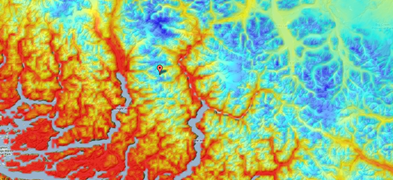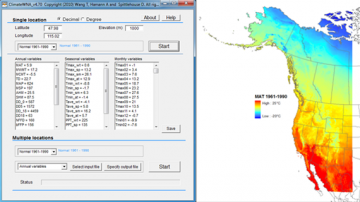
Climate change threatens our forests in a number of ways such as the possibility of locally adapted populations becoming unsuited to their new climate and increased risk of severe pathogen mortality. Without knowing what future climates will look like it would be difficult or impossible to create effective solutions to these and other problems. Members of the AdapTree team have been involved in creating and maintaining predictive climate models—ClimateBC and ClimateWNA—and projecting future climatic spaces for BC ecosystems and individual tree species.
ClimateBC &WNA are capable of outputting highly detailed data in British Columbia and western North America. Sometimes climate forecasting is done at rough resolutions (km2 for example) as the people using the programs are more concerned with larger trends. This low resolution data is less useful when dealing with plant ecology because small changes in topography, elevation, aspect and other factors can have large impacts on the surrounding plant community. Our climate programs factor in small changes to longitude, latitude and elevation to create higher resolution output. Output can be provided for 21 annual, 48 seasonal and 144 monthly climate variables. Some of the variables are of specific interest to those studying plant communities but may not be considered as important for other climate projection projects. This includes things like length of frost free days or length of optimal growing season.
With the climate data generated by ClimateBC/WNA, we are able to model and project the spatial distributions of Biogeoclimatic Ecosystem Classification (BEC) zones and individual tree species. The BEC system is used frequently by forestry and similar professionals to describe forest ecosystems and their climates in BC. Projected future climatic spaces for the BEC zones can be viewed giving another perspective on how climate change will impact forested ecosystems. By mapping individual species ranges you can also see how different species may respond to climate change. It should be noted however that the projected future climatic spaces for ecosystems or individual species represent their potential spatial ranges rather than actual migration of plant communities or species, which are also affected by non-climatic factors.
One problem with future climate f orecasting is the uncertainty in future climate. There are many different climate change scenarios that don’t always agree with one another. We however consolidated climate change scenarios and generate consensus projections. This increases reliability of forecasts, areas where the models are in high level of consensus are the most likely to be correct. On the converse side it is useful to know where models tend to disagree with each other because it represents areas where the future is more uncertain.
orecasting is the uncertainty in future climate. There are many different climate change scenarios that don’t always agree with one another. We however consolidated climate change scenarios and generate consensus projections. This increases reliability of forecasts, areas where the models are in high level of consensus are the most likely to be correct. On the converse side it is useful to know where models tend to disagree with each other because it represents areas where the future is more uncertain.
To effectively address issues related to climate change in forest management it was necessary for the AdapTree team to have access to, create and build upon robust climate predictions. ClimateBC/WNA and our consensus projections will allow us to place our genomics research within the context of future forest conditions and make useful policy recommendations to policy makers and industry end users.
For more information please contact Tongli Wang (tlwang@mail.ubc.ca)
